Menus
- 30 years of super athletes
- XR 41 previewed Suzuki GSX-R 750
- Stable and almost sociable
- The Yamaha FZ 750 won the tests
- The most important Superbike titles went to Honda
- Long distance title went to GSX-R for the first time
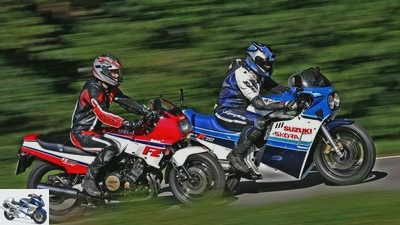
Hartmann

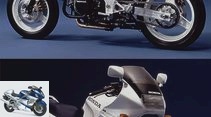
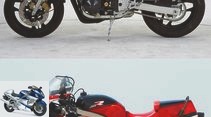
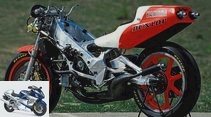
15th photos
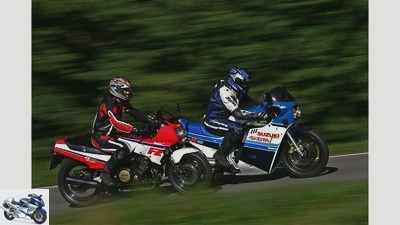
Hartmann
1/15
For the 100th birthday of the motorcycle 30 years ago, the most beautiful gifts came from Japan: Suzuki’s GSX-R 750, but also Yamaha’s FZ 750 redefined the topic of sport – and started a development avalanche.
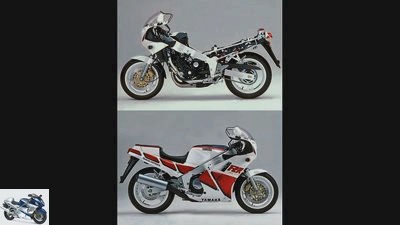
2/15
1987 Yamaha FZR 1000: In the year of its debut, the great sports Yamaha was still weak, but in 1989, with a pure bridge frame and a bearish engine, it finally became an icon.
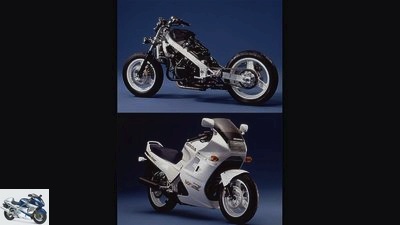
3/15
1986 Honda VFR 750: The concept of the aluminum bridge frame had long been tried and tested in the successful factory racing car, which is one of the reasons why the Honda VFR 750 was convincing for a long time.
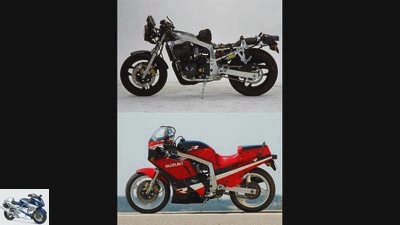
Archive / Bilski
4/15
1986 Suzuki GSX-R 1100: Of course, you couldn’t help it: Suzuki transferred the successful GSX-R concept to the large displacement class. However, the 1100 weighed significantly more than its sister.
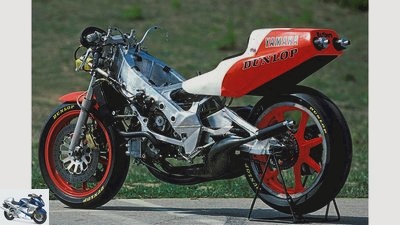
5/15
Thanks to the aluminum bridge frame, Yamaha’s YZR 500 could not be caught in 1984.
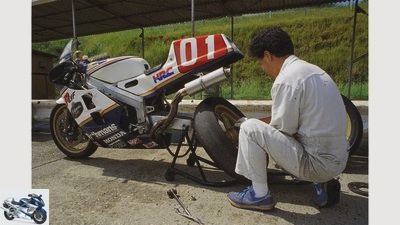
6/15
When the 750 cubic capacity limit applied in many series from 1985, the RVF 750 won a lot of titles for Honda.
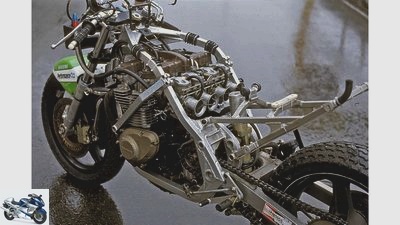
7/15
The factory-supported Kawasaki KR 1000 competed in the Endurance World Championship with this light alloy chassis from 1982 onwards.
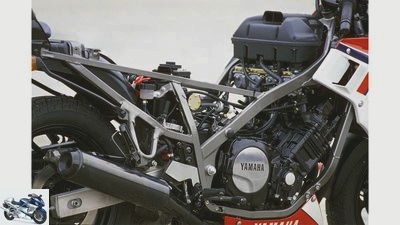
8/15
The frame, which is held flat at the rear, curves around the carburetor battery and the large air filter housing. He weighs – because steel – unfortunately a full 20 kilos.
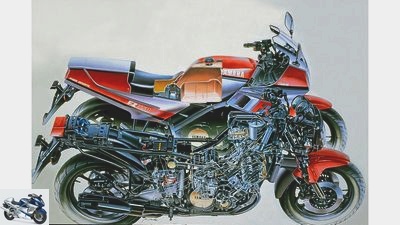
9/15
1985 Yamaha FZ 750: This is how modern works: The engine, which is inclined far forward (weight 68.5 kg) enables straight intake paths and ensures a favorable center of gravity – the FZ is surprisingly handy.
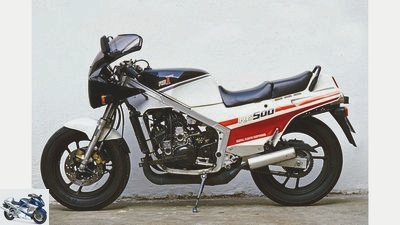
10/15
In 1985, the RG 500 Gamma steering head and swing arm bearings are visibly more directly linked than the GSX-R. Your aluminum frame weighs 9.2 kilos.
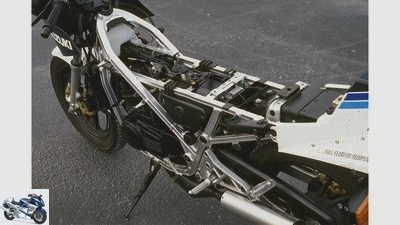
11/15
Suzuki did pioneering work in 1983 with the RG 250 Gamma. you
The first mass-produced motorcycle to have an aluminum frame.
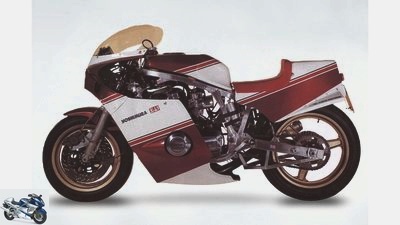
12/15
At the end of 1983 tuning pop Yoshimura presented his roadworthy GSX 802 R, also available as a hit with 750 cm³.
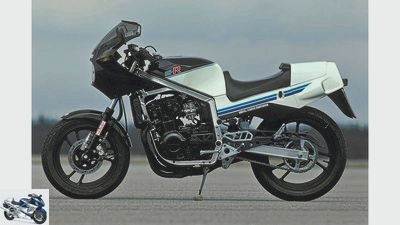
13/15
The GSX-R 400 anticipated the design and frame of the 750 series. Already at the beginning of 1984 she was very successful in attracting customers in Japan.

14/15
1985 Suzuki GSX-R 750: This is what winning machines looked like, and this is how they achieve their dream weight: The aluminum frame weighs a whole 10.7 kilos, the engine has 64, the four-in-one exhaust system 7.8. The fans had dreamed of this for a long time. Much too long.
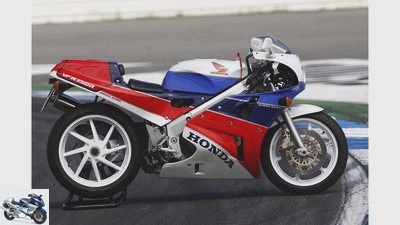
15/15
Summary: Because the Superbike World Championship required at least 1000 units to be built, Honda launched the VFR 750 R, called the RC 30. It combined Suzuki lightweight construction with the performance of modern chassis and engine technology.
Suzuki GSX-R 750 and Yamaha FZ 750
30 years of super athletes
Content of
For the 100th birthday of the motorcycle 30 years ago, the most beautiful gifts came from Japan: Suzuki’s GSX-R 750, but also Yamaha’s FZ 750 redefined the topic of sport – and started a development avalanche.
Nothing happens by chance, everything has a history. Even motorcycles, and especially those two top models that gave the 1984 IFMA the significance it still holds today. Two 750s, Suzuki GSX-R 750 and Yamaha FZ 750, thought more radically than seldom before and as hotly debated as recently the Honda’s CB 750. Both came on the market in the following year, both were, in very different ways, a bow to the customer: Okay, we understood, you want to really sport now, you really want new ideas, you want really high-tech. And both were the result of a tangible sales crisis: after a full two decades, the motorcycle boom had stalled in North America and Europe, people no longer blindly bought what fell off the assembly line in the Far East, they no longer believed every slogan.
Buy complete article
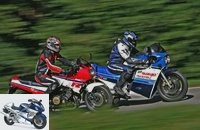
Suzuki GSX-R 750 and Yamaha FZ 750
30 years of super athletes
Aluminum was considered a high-tech material
The frames in road racing had little to no resemblance to the wide-reaching steel double loop. Increasingly, they followed the simple logic of connecting the control head and swing arm mounting as directly as possible by means of a light, yet rigid construction. Some – Bimota since the late 1970s in SB 1 – did this with an elegant tubular structure made of straight steel tubes, others – for example Kawasaki around 1982 for the successful 1000cc endurance racer – with a double loop made of rectangular aluminum tubes that was held flat at the back . In the Road World Championships, it was clear that the maximum counted: The greatest stiffness was promised by really full-fledged profiles, and that is why Yamaha’s YZR 500 – it helped Kenny Roberts to the runner-up title in 1983 and Eddy Lawson to the title a year later – clearly differentiated from the previously dominant one Honda NS 500 from: While the latter still carried an aluminum double loop, the Yamaha’s mighty aluminum profiles formed an ultra-torsion-resistant bridge frame that gently swung around the engine.
Aluminum was considered a high-tech material and full-blown fairy tales were woven around its processing. Material stresses could arise during welding, and this is where engine vibrations in particular would find the ideal field for their destructive work. This is how the regulars’ table, supported by conservative engineers, who saw a future at most in the steel bridge frame and the supporting engine. Kawasaki’s GPZ 900 from 1984 wore something like that, at least an aluminum rear end. It weighed 257 kilograms with a full tank. Otherwise she was great. In any case, more honest than Honda’s flagship athlete at the time, the 248 kilo VF 750 F, around whose V4 engine shimmered silver rectangular tube, but it was just painted steel. The Honda had to provide the visual material for the US Superbike series, which was limited to 750 cm³ from 1984. The championship mentioned and the long-distance sport that was popular in Europe and Japan, also limited in displacement from 1984 onwards, made racing with half-series motorcycles more and more popular – and put the manufacturers under real pressure. Everyone wanted to show a winning device, everyone had to reinvent it in 1984.
XR 41 previewed Suzuki GSX-R 750
Suzuki had done not badly until then, Wes Cooley even drove to two titles with his GS 1000 in the early stages of the US Superbike Championship. The engine block later formed the basis of the legendary long-distance racer XR 41, and this motorcycle provided a preview of the planned Suzuki GSX-R 750 as early as 1983. First of all, it had a double loop frame made of rectangular aluminum tubing, which was very similar to that of the later production motorcycle. Second, Suzuki changed the engine block of the 1000 series to significantly increase the oil capacity. An enlarged oil pump chased the lubricant particularly quickly through the inside of the engine – and thus increased the cooling capacity. In 1983 this package was enough for the title in the World Endurance Championship. Honda’s RVF grabbed the same in the first 750 cm³ year, but because the already established world champions had a pitch-black day at Bol d‘Or, the 750 Suzuki developed from the XR 41 achieved a prestigious double victory. That happened on Sunday, September 16th.
Four days later the IFMA opened in Cologne, the whole world saw the Suzuki GSX-R 750 – and knelt down. They really did it and built a street legal superbike. The new one looked like the face of the successful development bearers, and Pops Yoshimura remembered those who had a good memory: The starter had turned to Suzuki for some time, worked closely with the development department and at the end of 1983 had a motorcycle with aluminum Frame and heavily modified GSX 750 engine. Also available as a real hit. Surname? GSX 750 R.
Stable and almost sociable
Over 30 years create distance, the Suzuki GSX-R 750 has long since ceased to trigger fainting spells. But respect. Before the consequence with which chief engineer Etsuo Yokouchi was able to swear his people to the specifications: 200 kilograms ready to drive and 100 hp overwritten his specifications. These requirements permeate every component, from the front wheel rim to the rocker arm of the valve control to the rear axle mount. There is nothing that could be more easily eliminated or even eliminated entirely. At the beginning of 1984, Suzuki had presented a small 400cc for the Japanese market, one class higher was now being picked up again, and this escalation explains the staggering success of the GSX-R: of all things, in the displacement league in which the music played on the racetracks , Suzuki put out such a fan article. And unlike tricky two-stroke engines, this superbike was able to establish a connection to the racing circuit in a way that was perfectly suitable for everyday use.
Yokouchi and his people really had to fight to be sufficiently suitable for everyday use. When it came to the frame, they were not only able to fall back on experience with the GSX-R 400, but above all with the RG 250 Gamma, which was introduced in Japan in 1983 – Yokouchi was also responsible for the first series chassis made of light metal. Before and after the start of series production, he must have dealt intensively with its long-term durability. This is why not only the steering head tube with some tube attachments, but also the frame parts in the area of the swing arm bearings were cast on the Suzuki GSX-R 750. This avoided complicated and, above all, high-tension welding work. About the engine: Getting 100 hp out of 750 cc was already considered an easy task in the early 1980s. It was more difficult to make such a powerful engine stable (done) and manageable (almost done). Unlike the 400s, the 750s shouldn’t have water cooling for weight reasons. So she got a second oil pump so that her tight 5.5 liters of oil rush through the engine as quickly as possible and absorb a lot of heat in the process. Channels just above the combustion chambers, heavy spraying of the piston crowns, large oil coolers – nothing has been left out to keep the oil temperature within a reasonable range, even under high continuous loads. Result? While the predecessor engine from the GSX 750 heats its lubricant to 160 degrees at a sustained tempo of 200, the R variant leaves it at 120 degrees.
The Yamaha FZ 750 won the tests
With this techno trick, the Suzuki GSX-R 750 cheated its way through its series existence with great success for a few years, it was not until 1992 that it was thick and also got a water jacket. The second ’84 IFMA star had that right from the start, but he was only granted brief fame. Ingratitude is the world’s reward, Yamaha’s FZ 750 can truly tell a song about it. Both the chassis layout and the engine were clearly more promising than the Suzuki. Weight and styling, however, did not meet the requirements of the time. The scales stopped at 241 kilos when MOTORRAD asked the athlete to take a test. Athlete? Didn’t they have 40 kilos less bacon lately? On the chassis of the Suzuki GSX-R 750 only the side stand is made of steel, on the FZ only the swing arm is made of aluminum. She even carries a main stand around with her. But: The square main tubes of the double loop frame, viewed from the side and similar to the FJ 1100 presented in 1983, strive directly from the steering head to the swing arm mounting. Seen from above, in turn, they are very wide and encompass the air filter housing, which was huge for that time and enthroned above the cylinder head. That’s how you do it. Until today. Below that, the constant pressure carburetors supply the – naturally water-cooled – engine with fresh gas. They do it in a downdraft, better, more performance-based, greedy is not possible. Til today.
Even more. The gas exchange is done by five valves, three for the inlet and two for the outlet. Yamaha had cleverly reported on this arrangement well before IFMA, and discussions have raged since then. In addition to the whole aluminum box, free valve cross-sections, opening times, flushing losses, masses to be accelerated were quickly on the agenda – seldom did the regulars’ table get down to business so much. When the first test reports appeared in February 1985, all Yamaha fans celebrated a party, because the four-cylinder impressed with a suppleness that easily protruded into the realm of the 1000s. Wonderful acceleration from 2000 rpm. But then a never experienced angry revving up to well over 11,000 / min, as if painted, the performance curve. The first encounter with the GSX-R clearly revealed the motor superiority of the FZ. In spite of the additional weight, almost the same acceleration, much better torque, less fuel consumption, top speed too. If the Suzuki driver dared to leave the tap open up to 230 km / h due to the severe tendency to swing his somewhat too filigree aluminum mesh. And while the five-valve engine always reveals civilized serenity, the four-valve engine cannot hide the fact that it has to make an effort. Only with the help of flat slide carburetors does it achieve its measured 99 PS (Yamaha: 102), and with racing characteristics it delivers significantly less power up to 9000 tours. But because of game, set and win for Yamaha. The Yamaha FZ 750 won tests, the Suzuki GSX-R 750 cashed in.
The most important Superbike titles went to Honda
Of course, this dogged duel was always under particularly careful observation. Honda had also announced a new 750 for the 1985 season, and even disclosed the name and initial key data. The turmoil of battle between the two biggest pursuers and some anger with previous V4 engines made the world market leader wait. No VFR at IFMA. But still a little aluminum, namely the frame of the two-stroke three-cylinder rocket NS 400. That is something that is regularly forgotten when cheering around the Suzuki GSX-R 750: Super sports cars were created 30 years ago on several construction sites. The new four-stroke engines were based on the Superbike series, but if you wanted to offer that GP feeling, you inevitably did it in the two-stroke cycle. As a 400, the NS could hope for sales success in Japan, Honda found that that would have to be sufficient worldwide. The other way around, like Freddie Spencer’s winning machine, the engine has one vertical and two horizontal cylinders, but just like the 130 hp racer, the 72 hp series NS also impresses with its good drivability and wonderful handling. A little later, Suzuki poured half a liter, the rotary valve-controlled Square Four in the RG 500 pressed 95 hp, the whole thing weighed only 181 kilos thanks to the aluminum bridge. Makes 1.9 kilos per PS, 0.1 less than with the Suzuki GSX-R 750. By the way, Yamaha had already pushed ahead with the RD 500 in early 1984. Its 88 hp V4, however, was in a steel double loop made of rectangular tubes, similar to that of the Yamaha FZ 750. Except in technology-focused Japan, there was aluminum. The whole technical hubris could of course not prevent the approaching end of the two-stroke, all the more understandable that these three super athletes have long since achieved cult status as the last of their kind.
Back to the four-stroke: notwithstanding the new creations by Suzuki and Yamaha, the most important Superbike titles went to Honda in 1985. As in the previous year, Fred Merkel snatched the crown at the AMA Superbike Championship on the RVF 750, Igoa / Coudray Endurance World Champions were, as always, and just as naturally Joey Dunlop clinched his fourth Formula TT title for Honda. The V4 engine, originally developed from the VF 750 but radicalized with gear-driven camshafts, produced 125 to 130 hp, and the RVF weighed less than 160 kilos when dry. Accordingly, there was a slight disappointment when the VFR 750 F, which weighed 230 kilos with a full tank, appeared twelve months late at the end of 1985. In this country only in white or blue. Without any war paint, as a gentleman athlete, she set herself apart from the glaring competition. But in fact, as with the RVF, the famous gear cascades get a total of four camshafts going, the rectangular profiles of the aluminum frame, which is open at the bottom and led past the engine, peek out from the edges of the discreet full fairing. Only the finest and perfectly arranged, this could only result in a superior victory in the MOTORRAD group test.
Long distance title went to GSX-R for the first time
On the racetracks, however, there was a threat of trouble, the endurance title went to the Suzuki GSX-R 750 for the first time in 1987, and the Suzuki were getting closer in the AMA series. For the newly launched Superbike World Championship, Soichiro Honda demanded a real victory machine, just stupid that a 1000 series was required for homologation. Do you race with the VFR? Didn’t really work, so HRC (Honda Racing Corporation) built a small series of a Racer (from 1988 to 1992 a total of 4784 pieces) that had a lot more to do with the RVF than the VFR. And that is probably why everyone does not call it VFR 750 R, but according to the Honda factory code RC 30. A universal weapon that comes from the Superbike World Championship (under Fred Merkel), Formula TT (Carl Fogarty) and AMA series (Bubba Shobert ) won, then again in 1989 the Endurance World Championship (Alex Vieira), which finally proved two things: The diet specialists from Suzuki were great, and the Yamaha technicians were right. To a: Despite the aluminum tank, magnesium valve covers and titanium connecting rods, a fully fueled RC 30 weighed seven kilos more than the GSX-R, namely 208. To b: Of course, it had water cooling and straight intake ducts, an aluminum Frame anyway.
As expected, the technical war of faith raged soon after the appearance of the Suzuki GSX-R 750 and Yamaha FZ 750 in the large displacement class too. In 1986, Suzuki adapted the 750 concept in the GSX-R 1100 almost one-to-one. Yamaha proved to be capable of learning and in the following year hung the four-cylinder five-valve engine of the FZR 1000 in an aluminum bridge frame that projected to the side but had steel beams and not really convinced. The GSX-R only narrowly won the fight on the scales, weighing 230 to 234 kilos. Again, Honda held back at first elegantly. Then came the CBR 1000, won comparison tests, but with its 262 kilos is not allowed to play in this story. In tow, however, she had a 600, which despite its steel frame only weighed 201 kilos, played cat and mouse with her classmates and – this much soon became clear – opened a new segment. It will be allowed to wear the H license plate in three years’ time and then get its great Classic story.
Postscript: In 1989 Yamaha left out the stupid joists on the FZR 1000 and carried the engine with them. Now the weight was 247 (GSX-R) to 236 kilos. Finally, after all these years.
Related articles
-
Comparison test of supersports: Honda CBR 600 F, Kawasaki ZX-6R, Suzuki GSX-R 600, Yamaha YZF 600 R
Comparison test of super sports cars: Honda CBR 600 F, Kawasaki ZX-6R, Suzuki GSX-R 600, Yamaha YZF 600 R Let’s twist again Wake up, people. In the 600s …
-
Suzuki RG 500 and Suzuki GSX-R 750 in comparison
MOTORRAD CLASSIC on the move: Suzuki sports motorcycles 1984 Competitors: Suzuki RG 500 and Suzuki GSX-R 750 Contents from Suzuki presented in 1984 …
-
Suzuki GSX-R 750 – The super sports car in the three-quarter liter class
Bilski 14th photos Manufacturer 1/14 1998 – Injection system, steering damper, unbelievable 135 hp, reduced gear ratio, torque-increasing manifolds….
-
Comparison test Honda CB 1300 S, Suzuki Bandit 1200 S, Yamaha FZ1 Fazer
Bilski comparison test Honda CB 1300 S, Suzuki Bandit 1200 S, Yamaha FZ1 Fazer search for traces They have sporty roots in common. At the Honda in …
-
Motocross Comparison Test – Honda, Kawasaki, KTM, Suzuki and Yamaha
Jahn 16 pictures Jahn 1/16 Kawasaki KX 450 F, KTM 350 SX-F, Yamaha YZ 450 F, KTM 450 SX-F, Suzuki RM-Z 450 and Honda CRF 450 R in the large MX1 (450cm³) …
-
fact Concept comparison Honda CBR 1100 XX Kawasaki ZX-12 R Suzuki GSX-R 1000 Suzuki GSX 1400 Yamaha FZS 1000 Fazer Yamaha FJR 1300 Six bombs The six …
-
Comparison test: Honda CX 500-650 Turbo, Kawasaki Z 750 Turbo, Suzuki XN 85, Yamaha XJ 650 Turbo
Jahn 21 pictures Jahn 1/21 The preload of the central spring strut of the Suzuki can be easily adjusted. Jahn 2/21 Tight corners and fast …
-
Honda, Kawasaki, KTM, Suzuki and Yamaha Crosser in the test
Honda comparison test: Motocross MX2 (up to 250 cm³) Crosser from Honda, Kawasaki, KTM, Suzuki and Yamaha in the test For two years the Suzuki RM-Z has dominated …
-
On the move: Honda VF 1000 R, Kawasaki GP Z 900 R, Suzuki GSX-R 1100
Jahn On the move: Honda VF 1000 R, Kawasaki GP Z 900 R, Suzuki GSX-R 1100 Technical revolution Contents of They drove us crazy – and …
-
Suzuki GSR 600, Triumph Street Triple, Yamaha FZ6 Fazer S2
Artist Suzuki GSR 600, Triumph Street Triple, Yamaha FZ6 Fazer S2 Comparison test of mid-range bikes Middle-class bread and butter? That was once. All…